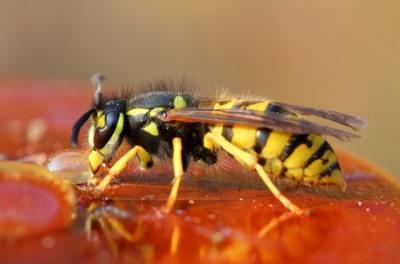
Call 999 Pest Control NOW on
07775 801190
to resolve your WASP problems
Distribution
Wasps are found throughout Britain and are probably the most familiar and generally disliked of all British insects. Their bodies bear the characteristic black and yellow bands and they have a narrow waist in the middle of the body. The worker is 10-15mm in length and the queen is usually 20mm in length, both have two pairs of wings which lock together. Only females have the ability to sting, which is near the tip of the abdomen.
Several species of wasp exist in the UK but most abundant are the Common and German wasps. Both these species nest underground or in the cavities of trees, walls and other parts of buildings.
The queen emerges from the nest in the autumn and after mating selects a suitable site for hibernation. Late in the following spring hibernation comes to an end and the surviving queens select a nest site. The nest is usually located in the ground or in roof cavities and is built from wood pulp which is moulded into the outer shell of the nest and contains many internal chambers. The queen lays an egg into each of the chambers and these hatch into larvae which are fed by the queen on dead insects. When fully grown the larvae pupate and from the pupae sterile workers emerge. These workers assist in rearing new larvae and the new queens.
Towards the end of the summer the queen lays a number of eggs which produce male wasps and these mate with the new queens. As the weather becomes colder in late autumn, all the wasps die except the new queens which fly away to find sites for hibernation. The old nests are not re-used the following year.
The benefits from wasps are not, however, so widely appreciated for in the spring and early summer wasp grubs are fed on other inspect pests.
Pest concerns
- Wasps can be a nuisance but are not responsible for the spread of disease.
- The sting is caused by an injection of venom into the victim. Unlike the sting of a bee, the wasp sting can be withdrawn from the victim and used again, wasps can be extremely aggressive.
- A wasp can sting multiple times which can cause anaphylactic shock to the victim. In extreme cases a hospital visit may be needed, if stung by a wasp multiple times.
- Wasp nests should be approached with extreme caution. Multiple stings can be very dangerous. Wasps have a very powerful sting and readily use it to defend the nest or themselves. Unlike bees, which are quite passive, wasps can be very aggressive.
- Wasp nests may be found in roof spaces, wall cavities and air grates of buildings, hanging from trees as well as in underground tunnels.
- Wasps are known to cause serious damage to ripened fruit and are generally a nuisance when attracted to sweet smelling foods.
Control measures
Wasp nests which pose a particular danger to your family or other members of the public should be professionally treated otherwise they should be left undisturbed.
If you should need professional advice or help regarding wasps please call 999 Pest Control on 07775 801190
